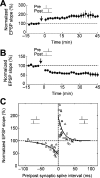Experimental and computational aspects of signaling mechanisms of spike-timing-dependent plasticity
- PMID: 20119481
- PMCID: PMC2799986
- DOI: 10.2976/1.3137602
Experimental and computational aspects of signaling mechanisms of spike-timing-dependent plasticity
Abstract
STDP (spike-timing-dependent synaptic plasticity) is thought to be a synaptic learning rule that embeds spike-timing information into a specific pattern of synaptic strengths in neuronal circuits, resulting in a memory. STDP consists of bidirectional long-term changes in synaptic strengths. This process includes long-term potentiation and long-term depression, which are dependent on the timing of presynaptic and postsynaptic spikings. In this review, we focus on computational aspects of signaling mechanisms that induce and maintain STDP as a key step toward the definition of a general synaptic learning rule. In addition, we discuss the temporal and spatial aspects of STDP, and the requirement of a homeostatic mechanism of STDP in vivo.
Figures




Similar articles
-
Hebbian Spike-Timing Dependent Plasticity at the Cerebellar Input Stage.J Neurosci. 2017 Mar 15;37(11):2809-2823. doi: 10.1523/JNEUROSCI.2079-16.2016. Epub 2017 Feb 10. J Neurosci. 2017. PMID: 28188217 Free PMC article.
-
Endocannabinoids mediate bidirectional striatal spike-timing-dependent plasticity.J Physiol. 2015 Jul 1;593(13):2833-49. doi: 10.1113/JP270324. Epub 2015 May 13. J Physiol. 2015. PMID: 25873197 Free PMC article.
-
Stochastic spike synchronization in a small-world neural network with spike-timing-dependent plasticity.Neural Netw. 2018 Jan;97:92-106. doi: 10.1016/j.neunet.2017.09.016. Epub 2017 Oct 12. Neural Netw. 2018. PMID: 29096205
-
Does spike timing-dependent synaptic plasticity underlie memory formation?Clin Exp Pharmacol Physiol. 2007 Oct;34(10):1070-6. doi: 10.1111/j.1440-1681.2007.04724.x. Clin Exp Pharmacol Physiol. 2007. PMID: 17714096 Review.
-
Spike timing-dependent plasticity of neural circuits.Neuron. 2004 Sep 30;44(1):23-30. doi: 10.1016/j.neuron.2004.09.007. Neuron. 2004. PMID: 15450157 Review.
Cited by
-
An evaluation of neuroplasticity and behavior after deep brain stimulation of the nucleus accumbens in an animal model of depression.Neurosurgery. 2011 Dec;69(6):1281-90. doi: 10.1227/NEU.0b013e3182237346. Neurosurgery. 2011. PMID: 21566538 Free PMC article.
-
Challenges in Reproducibility, Replicability, and Comparability of Computational Models and Tools for Neuronal and Glial Networks, Cells, and Subcellular Structures.Front Neuroinform. 2018 May 1;12:20. doi: 10.3389/fninf.2018.00020. eCollection 2018. Front Neuroinform. 2018. PMID: 29765315 Free PMC article.
-
Postsynaptic signal transduction models for long-term potentiation and depression.Front Comput Neurosci. 2010 Dec 13;4:152. doi: 10.3389/fncom.2010.00152. eCollection 2010. Front Comput Neurosci. 2010. PMID: 21188161 Free PMC article.
-
The critical balance between dopamine D2 receptor and RGS for the sensitive detection of a transient decay in dopamine signal.PLoS Comput Biol. 2021 Sep 30;17(9):e1009364. doi: 10.1371/journal.pcbi.1009364. eCollection 2021 Sep. PLoS Comput Biol. 2021. PMID: 34591840 Free PMC article.
-
Analysis of development of direction selectivity in retinotectum by a neural circuit model with spike timing-dependent plasticity.J Neurosci. 2011 Jan 26;31(4):1516-27. doi: 10.1523/JNEUROSCI.3811-10.2011. J Neurosci. 2011. PMID: 21273436 Free PMC article.
References
LinkOut - more resources
Full Text Sources
